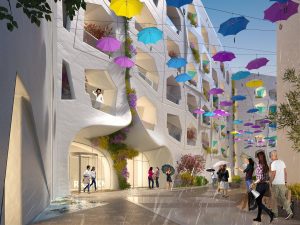Kleindienst Group, developer of The Heart of Europe – the US$5 billion (Dh18.3 billion) master-planned leisure tourism island destination – has started developing a 1-kilometre long innovative and sustainable ‘Raining Street’ project that will offer rainfall throughout the year in the Europe Island surrounded by hotels and resorts, making it a major tourist attraction when Phase I of the project opens later this year.
A home grown innovation envisioned by Josef Kleindienst, Chairman of Kleindienst Group and backed by Fraunhofer Institute, Europ’s largest application-oriented research organization, the Rainy Street will be a game-changer in attracting tourists to the Heart of Europe.
An engineering marvel, the Raining Street will offer year-round rainfall that will reduce the temperature to 27 degree Celsius during the summer season providing enough cooling. The Raining Street will be have a boulevard setting filled with street cafe, casual dining restaurants, retail outlets, fashion and souvenir shops. It will also host as many as 51 year-round European festivals that will enthrall local and international tourists.
“The Heart of Europe is an innovative and sustainable leisure tourism destination being built on a cluster of seven islands 4 kilometres off the coast of Dubai that will offer the best of European culture, heritage, cuisine and environment,” Josef Kleindienst, Chairman of Kleindienst Group, says.

“The vision behind the project is to offer the best European experiences to residents and tourists here in the UAE. It is an innovative, iconic and sustainable project. So, when we planned the project way back in 2007-08, we had looked at various possibilities to make it exceptional that is backed by innovative technologies to re-create the European climate in Dubai.
“We looked at a number of references for developing ideas and research institutes to support us to transform the vision into reality. After years of research and testing, I am glad to announce that we are now constructing the Rainy Street that we expect to deliver as part of the Phase 1 development later this year.”
The Rainy Street is inspired by a 150-year-old architectural concept of Camillo Sitte, an Austrian architect, who proposed to build cities where everything was in walking distance.
“We are following Camillo Sitte’s idea of cities built with streets and boulevards within walkable distances. But to be able to walk from one place to another you should have the right climate,” Josef Kleindienst Says.
“With the temperature ranging between 40 to 50 degrees Celsius during summer, people are not going to walk outside. Therefore, we need a technology to create an outdoor climate-controlled area. So, we contacted engineers and consultants from the European institute who visited Dubai in 2008 to understand the climate here and conduct their research.”
The technology interferes with the temperature, humidity and wind to ensure a cooler clime outdoor. The rainy street is also a sustainable project as it uses solar energy and it produces zero carbon emission.
“Fraunhofer engineers asked us if we wanted to reduce the temperature as in any other buildings and malls by using cold air, or we wanted cold water in the form of rain. We opted for rain as we knew people would love it, especially in the summer season,” he says.
“The technology ensures that as soon as the temperature goes above 27 degrees Celsius on the island, cold water in the form of rain will fall from top of the buildings through concealed pipes. As the buildings take shape, we have started the engineering works to set up the Rainy Street within the European Island of the Heart of Europe, which will be surrounded by hotels and resorts.
“But in one of the plazas on the island, we will control the temperature through technical snow produced from water that will be environment-friendly.”
The rainy street will be strategically located on Main Europe island, next to the Portofino family hotel, Marbella hotel and the Côte d’Azur resort, a cluster of hotels inspired by the lifestyle from Southern Europe. The street will cross the island allowing visitors and families to stroll along the vibrant high street and its line-up of boutique retail offering, all year long, as if in Europe.
The Heart of Europe is set to become one of the most scenic and experiential luxury destinations in the Middle-East and the world. The project, which combines high levels of sustainability with innovation, will add 15 atmospheric and highly differentiated hotels to the Dubai offering, 4,000 holiday homes, the iconic Floating Seahorse Villas and the beachfront boutique hotels at Cote d’Azur and Portofino resorts.
With sustainability at its core, the Heart of Europe will see the development of more than 500,000 square metres of coral reefs and feature Spanish olive trees that are between 100 and 1,500 years old that were sourced from Andalusia, a region in Spain’s southern coast, and the world’s first climate controlled rainy street and snow plaza.
The island will host magnificent hanging gardens on the façade of the Portofino inspired hotel with an astonishing 31,000 plants. It will also offer sustainable entertainment with zero emissions with no harm to nature such as hologram circus and synchronized swimming shows.
The Heart of Europe will also deploy sustainable landscaping that will be pesticide free, fungicide free and will be showered with recycled water. The island is also committed to be totally car free, use clean energy and will eventually offer sustainable water transportation to the guests.
The Heart of Europe was designed with a zero-discharge policy and zero micro-plastics policy to ensure the protection of the Arabian Gulf and species of marine life that reside around the seven islands.
Organic food will be served across the destination’s restaurants and cafes and the 24/7 room service offerings, adding health and wellness to the incredible beauty of the islands.